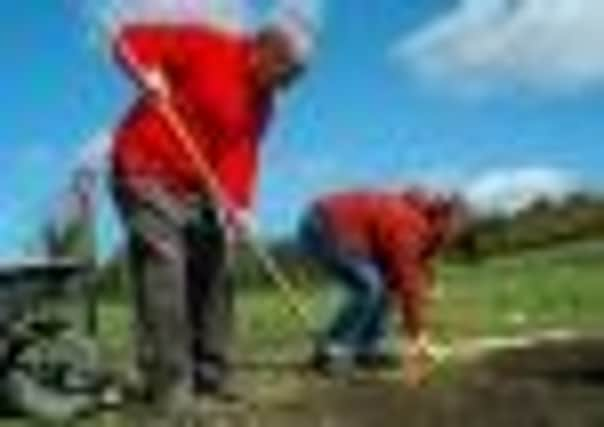Organic farm creates a living landscape


Stirley Community Farm is emerging from Castle Hill’s shadow. This former upland dairy farm, at the foot of Huddersfield’s most recognisable landmark, had been out of business for eight years before Yorkshire Wildlife Trust took it under its wing.
It is the first farm the trust has managed in its 65-year history.
Advertisement
Hide AdAdvertisement
Hide AdMuch of Stirley’s 250 acres was vacant or in disrepair when the owners, Kirklees Council, handed it to the Trust on a 25-year lease.
Aided by the Big Lottery Fund’s Local Food scheme, the trust has begun transforming the farm into a flagship for grassland management and sustainable food production, aimed at inspiring farmers, gardeners and children.
Their food education officer Kim Warren explains: “The trust has come to realise that small scale nature reserves aren’t always successful at conserving species. On the contrary, isolating habitats from people and the wider landscape can put some species at risk.”
Kim, who previously worked for Jamie Oliver on his vegetable garden in Essex, has developed 48 organic vegetable training beds at Stirley, with help from volunteers and local groups.
Advertisement
Hide AdAdvertisement
Hide AdThe farm, she explains, is what the trust calls a “living landscape”. “Food is something we all relate to, so we can introduce new audiences to our message of wildlife conservation.”
Kim has been showing local children and adults how easy growing food can be, sowing seeds straight into the ground, including Cavolo Nero, also known as Tuscan or winter kale, and Koralik tomatoes, a hardy eastern European bush variety. “Everybody’s been amazed at the success we’ve had from the vegetable beds,” she says. “Our training beds, soft fruit hedges, forest garden and formal orchard demonstrate different ways of producing food and also create a range of habitats.
“We hope to inspire people to take what they learn home and create their own wildlife haven in their back garden.”
Tending an isolated Pennine hillside is a far cry from working for a celebrity chef, but Kim has found an outlet for her passion at Stirley.
Advertisement
Hide AdAdvertisement
Hide Ad“One striking realisation for organic farmers and gardeners is how successful a balanced ecosystem is to the control of pests and diseases in both plants and animals,” she says.
“If predators such as frogs and hedgehogs are absent, slug populations will soon rise. Nettle beds can be left to feed caterpillars instead of our cabbages. Repeated overgrazing of grassland will cause livestock to require frequent and expensive doses of wormers.”
She hopes to welcome schools to Stirley Farm for the first time this year. “The farm will serve as a demonstration of extensive farming in the Pennine urban fringe.” With the arrival of a herd of English Shorthorn beef cattle, Stirley is also on its way to becoming a viable beef enterprise. The farm enterprise manager, Ian Smart, has been working with trainees and volunteers to prepare the farm buildings and boundaries for the cattle. The first herd arrived last autumn, and is being overwintered in a newly renovated barn.
The shorthorns were chosen for their docile nature and hardiness because the public is being encouraged to walk the footpaths which lace the site. Beef from the herd is expected to be available in local shops in 2014.
Advertisement
Hide AdAdvertisement
Hide AdCattle are very much part of the desired ecosystem. Kim says: “Livestock has been used to graze nature reserves on trust land for decades. Animals select certain plants to eat where a machine will cut indiscriminately, thus grazing creates a more species-rich sward.
“The hummocks and hollows from hoof prints form tiny ecosystems for invertebrates, manure creates localised patches of soil fertility suited to certain plant species and a food source for insects which in turn feed bird populations.” The trust sees Stirley as the centre of a meadow restoration scheme that will help halt the loss of these habitats.
It is managing the meadows as a low input system and is working with nearby landowners to ensure the farm is not isolated in its approach. Its neighbours at Castle Hill are managing their sites in the same way, and the nearby Farnley Tyas estates are managing their farmland at “entry level stewardship”.
Stirley will, the trust says, become a crucial part of the West Yorkshire living landscape.
Advertisement
Hide AdAdvertisement
Hide AdKim says it has made her see food growing in a new light: “The more I think about it, the more I realise wildlife and food are inextricably linked.When we grow food we become more attuned to the change in seasons and the necessity to care for all the elements such as soils, rainfall, plants and animals.
“By eating locally produced, seasonal food we can practice conservation farming and secure a higher value for well managed land close to the supply chain. This makes our practices more financially sustainable and promotes greater biodiversity than traditional farming practices.”
Donations needed to secure grant
A £300,000 grant from Veolia Environmental Trust’s Cre8 Funding Challenge is enabling Yorkshire Wildlife Trust to begin renovating one of the buildings at Stirley Farm to create an education centre. The trust needs to raise £30,000 match funding from its supporters to secure the grant. To donate visit justgiving.com/YWT-Stirley.
Yorkshire Wildlife Trust volunteers conducted habitat mapping and mammal trapping surveys of the entire farm, revealing the presence of wood mice and bank voles. Huddersfield Birdwatchers Society is also surveying the site.